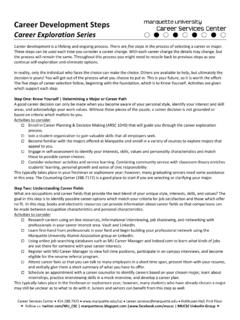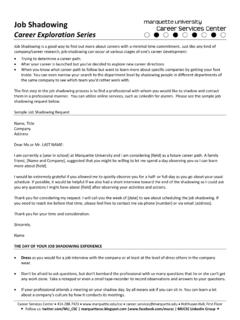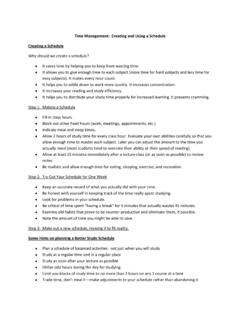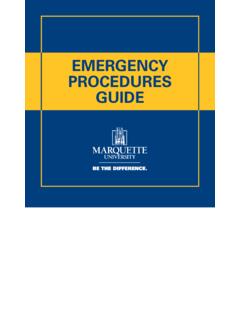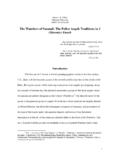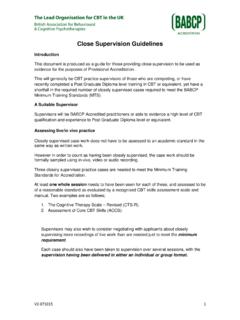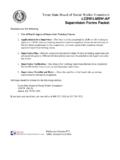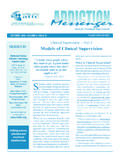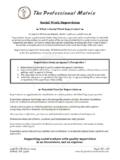Transcription of A BRIEF SUMMARY OF SUPERVISION MODELS - …
1 A BRIEF SUMMARY OF SUPERVISION MODELS by Kendra L. Smith, , LPC, ACS September 2009 Clinical SUPERVISION for mental health professionals started out much like apprenticeships in other fields. That is, a student/apprentice with minimal skill/knowledge would learn the work by observing, assisting, and receiving feedback from an accomplished member of the same field. It was believed that because the master was quite good at the work, he or she would be equally good at teaching/supervising. In fact, this is not the case. Today, we realize that, though clinical SUPERVISION and counseling have much in common ( , the ability to engage in an interpersonal relationship), the two tasks also utilize separate and distinct skills.
2 This means that a master clinician may not be always be a master supervisor without the addition of training and competency in supervisory knowledge and skills. Furthermore, the concept of master-apprentice SUPERVISION evokes a hierarchy of power that favors the master as the authority, a dynamic that is not supported in today s literature on SUPERVISION . It is also documented that clinical knowledge and skills are not as easily transferrable as the master-apprentice model implies (Falender & Shafranske, 2008). Observing experienced clinicians at work is without question a useful training tool, but is not sufficient to help students develop the skills necessary to become skilled clinicians themselves. Development is facilitated when the supervisee engages in reflection on the counseling work and relationship, as well as the SUPERVISION itself.
3 Thus, clinical SUPERVISION is now recognized as a complex exchange between supervisor and supervisee, with supervisory MODELS /theories developed to provide a frame for it. In an effort to give the reader a foundation for understanding different SUPERVISION MODELS , this article highlights information gathered from a variety of authors on the topic of SUPERVISION . It does not represent all MODELS of SUPERVISION , nor does it provide a comprehensive description of each supervisory model presented. Rather, the following presents salient defining characteristics of selected MODELS . For further learning, readings from the reference section at the end of this paper may be helpful. Psychotherapy-Based SUPERVISION MODELS As explained above, clinical SUPERVISION started as the practice of observing, assisting, and receiving feedback.
4 In this way, SUPERVISION follows the framework and techniques of the specific psychotherapy theory/model being practiced by the supervisor and supervisee. As the need for specific supervisory interventions became evident, supervisory MODELS developed within each of these psychotherapy theories/ MODELS to address this need. Psychotherapy-based MODELS of SUPERVISION often feel like a natural extension of the therapy itself. Theoretical orientation informs the observation and selection of clinical data for discussion in SUPERVISION as well as the meanings and relevance of those data (Falender & Shafaanske, 2008, p. 9). Thus, there is an uninterrupted flow of terminology, focus, and technique from the counseling session to the SUPERVISION session, and back again.
5 Several examples of specific psychotherapy-based SUPERVISION MODELS are described briefly below. Readers interested in learning more about a specific psychotherapy-based SUPERVISION approach are referred to the references for further reading. Psychodynamic Approach to SUPERVISION : As noted above, psychodynamic SUPERVISION draws on the clinical data inherent to that theoretical orientation ( , affective reactions, defense mechanisms, transference and countertransferece, etc.). Frawley-O Dea and Sarnat (2001) classify psychodynamic SUPERVISION into three categories: patient-centered, supervisee-centered, and supervisory-matrix-centered. Patient-centered began with Freud and, as the name implies, focuses the SUPERVISION session on the patient s presentation and behaviors.
6 The supervisor s role is didactic, with the goal of helping the supervisee understand and treat the patient s material. The supervisor is seen as the uninvolved expert who has the knowledge and skills to assist the supervisee, thus giving the supervisor considerable authority (Frawley-O Dea & Sarnat, 2001). Because the focus is on the patient, and not on the supervisee or the supervisory process, very little conflict occurs between supervisor and supervisee, as long as they both interpret the theoretical orientation in the same way. This lack of conflict or stress in the SUPERVISION sessions often reduces the supervisee s anxiety, making learning easier. Conversely, if conflict were to develop using this model, SUPERVISION could be impeded by not having a way to deal directly with it (Frawley-O Dea & Sarnat).
7 Supervisee-centered psychodynamic SUPERVISION came into popularity in the 1950s, focusing on the content and process of the supervisee s experience as a counselor (Frawley-O Dea & Sarnat, 2001; Falender & Shafranske, 2008). Process focuses on the supervisee s resistances, anxieties, and learning problems (Falender & Shafranske). The supervisor s role in this approach is still that of the authoritative, uninvolved expert (Frawley-O Dea & Sarnat), but because the attention is shifted to the psychology of the supervisee, SUPERVISION utilizing this approach is more experiential than didactic (Falender & Shafranske). Supervisee-centered SUPERVISION was adapted to fit several psychodynamic theories, including Ego Psychology, Self Psychology, and Object Relations (Frawley-O Dea & Sarnat, 2001).
8 Supervisee-centered SUPERVISION can stimulate growth for the supervisee as a result of gaining an understanding of his/her own psychological processes, but this same advantage can also be a limitation in that it makes the supervisee highly susceptible to stress under scrutiny. The supervisory-matrix-centered approach opens up more material in SUPERVISION as it not only attends to material of the client and the supervisee, but also introduces examination of the relationship between supervisor and supervisee. The supervisor s role is no longer one of uninvolved expert. SUPERVISION within this approach is relational and the supervisor s role is to participate in, reflect upon, and process enactments, and to interpret relational themes that arise within either the therapeutic or supervisory dyads (Frawley-O Dea & Sarnat, 2001, p.)
9 41). This includes an examination of parallel process, which is defined as the supervisee s interaction with the supervisor that parallels the client s behavior with the supervisee as the therapist (Haynes, Corey, & Moulton, 2003). Feminist Model of SUPERVISION : Feminist theory affirms that the personal is political; that is, an individual s experiences are reflective of society s institutionalized attitudes and values (Feminist Therapy Institute, 1999). Feminist therapists, then, contextualize the client s and their own experiences within the world in which they live, often redefining mental illness as a consequence of oppressive beliefs and behaviors (Feminist Therapy Institute; Haynes, Corey, & Moulton, 2003).
10 Feminist therapy is also described as gender-fair, flexible, interactional and life-span oriented (Haynes, Corey, & Moulton, p. 122). The Ethical Guidelines for Feminist Therapists (Feminist Therapy Institute, 1999) emphasizes the need for therapists to acknowledge power differentials in the client-counselor relationship and work to model effective use of personal, structural, and institutional power. Though the Guidelines do not specifically address the supervisee-supervisor relationship, it can be assumed that the same tenets apply to this latter relationship. That is, the supervisor-supervisee relationship strives to be egalitarian to the extent possible, with the supervisor maintaining focus on the empowerment of the supervisee.
